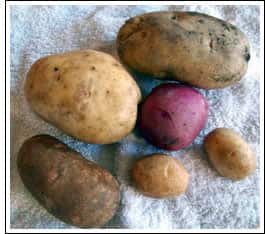 Why Grow Your Own Potatoes?
Why Grow Your Own Potatoes?
We can improve resiliency, health, and quality of life by growing our own vegetables locally. Many of the vegetables commonly grown in backyard gardens, such as lettuce, tomatoes, and carrots ,are great sources of vitamins and minerals but are not as high in energy content as measured by calories. Much of our daily caloric needs come from staple grains (wheat, corn, rice) which are difficult to produce from a backyard garden due to the time, space, and effort required. Fortunately the potato is an energy dense vegetable with many advantages for the part-time gardener, including:
- Easy and rewarding to grow
- Store well with minimal effort
- Nutritious source of carbohydrates as well as fiber, vitamins, and minerals.
- Simple to prepare
- Homegrown potatoes taste great!
History
Potatoes originated in southern Peru in South America. Spanish sailors are believed to have brought the potato to Europe in the 16th century, where it became a major food resource by the 1800s. Potatoes have become a widely consumed crop in the US as well, and it is clear that potatoes have a lot more to offer beyond French fries.
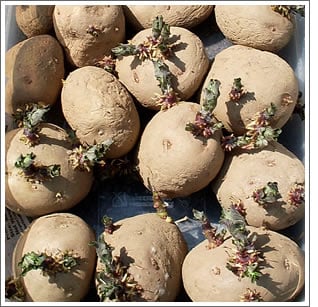 Seed Potatoes
Seed Potatoes
Potato plants are grown from seed potatoes, which are simply small potatoes or larger cut-up tubers. Certified seed potatoes from an established supplier are recommended to ensure they are disease free and certainty of the variety. Some mail order sources for seed potatoes are listed in the references at the end of this article if you do not have a local source.
Be sure to order seed potatoes in the early spring before they sell out. Supermarket potatoes might work in a pinch, but they are not ideal to use because they may be treated to inhibit sprouting.
Chitting or green sprouting prior to planting is recommended to encourage early growth. Store your seed potatoes in a warm area with indirect sunlight for 2 or more weeks until sprouts form from the eyes. I don’t bother to cut seed potatoes before planting, but if you choose to cut them, follow the recommendations of the supplier.
To figure how much seed you will need, 10 pounds of seed plants about 80 feet at 12’ spacing. A typical yield for me is about 5 to 10 pounds of potatoes for every linear 10 feet.
Planting
Potatoes grow in most well-drained fertile soils with decent sunlight. They need lots of space, so you may want to save your raised beds for other veggies. I use a different area each year to plant potatoes in my backyard, rotating with other space-consuming crops such as corn and squash. So far I have not had any problems with disease.
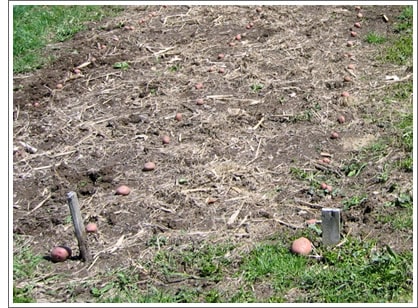 Wait to plant until the soil is 55-60 degrees F and dry enough to work before planting to reduce the risk of seed decay. This past spring I planted in early May on a warm weekend, only to be hit with a period of cold wet weather. Nothing came up, but fortunately a replanting 4 weeks later was much more successful.
Wait to plant until the soil is 55-60 degrees F and dry enough to work before planting to reduce the risk of seed decay. This past spring I planted in early May on a warm weekend, only to be hit with a period of cold wet weather. Nothing came up, but fortunately a replanting 4 weeks later was much more successful.
Seed potatoes are typically recommended to be planted in a furrow 4” to 6” deep, spaced about 12” apart, with rows at least 2' - 3' on center. However, the no-till, no-dig method makes growing potatoes easy! Simply place the seed pieces on the surface of the ground – dirt, low grass areas, or whatever. I string out a long tape measure to keep neat rows, or you can place seed randomly. Cover with mulch and you’re done!
Mulch can include hay, straw, leaves, compost, or reportedly even newspaper. I use composted yard waste for free from the local transfer center and my own backyard pile.
There are several great advantages to the no-dig method:
- Saves labor and machinery needs
- Preserves soil structure and retains moisture
- Allows seed to warm up
People with limited space can still grow potatoes in many ways using containers, bags, or towers. I don’t have experience with this, but hopefully others can share their success.
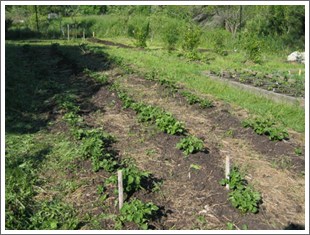 Hilling
Hilling
The purpose of hilling is to add more soil or mulch around the plants so that new tubers can form between the seed pieces and the soil surface. Hilling allows the plants to preserve moisture and protects tubers from sunlight.
Hilling should be done when the plants are 6” to 12” tall, about 3 or 4 weeks after planting, sufficient to cover most but not all of the plant. Hill a second time when the plants are again 6”-8” tall if you get a chance, but the second hilling is less critical. I hill by adding more mulch with a wheelbarrow and shovel. You can also use a hoe to move adjacent soil or mulch along each row if your soil is workable.
Other than hilling, very little weeding is required. The potato plants should soon be big enough to shade and out compete weeds. I pull out the big weeds or run down between rows with a stirrup hoe if I have time, but don’t worry much if I can’t get to it.
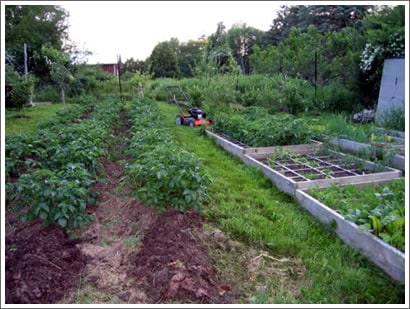 Harvesting
Harvesting
New potatoes can be “robbed” anytime after about 60 days. It is fun to go out just before supper and reach carefully around the plant roots in the soil with your hand to steal new potatoes. They are light-skinned and delicious.
Potatoes are mature when the tops start to die back. Leave the potatoes in the ground at least another two weeks to allow the skins to toughen. Delaying digging until cool weather comes is desirable for long term storage, and some folks report good luck storing potatoes in the ground until frost. However, quality may deteriorate if potatoes are left in wet soil too long or you have problems with bugs. I use judgment as the season goes based on the weather and my available time.
To avoid damaging the spuds I like to dig potatoes with my hands and gloves, which is easily done in the loose compost. If you can time it right, it’s worth waiting a few days after the last rain event so you don’t end up with potatoes covered with mud.
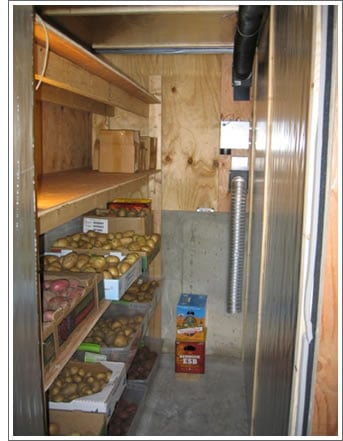 Storing
Storing
Loose dirt may be brushed off but washing potatoes is not necessary or recommended. I have washed potatoes though when I’ve had to dig them in wet conditions but have had no problems with storage as long as I let them dry out thoroughly first.
Cull out potatoes not fit for long term storage. Damaged spuds may be eaten soon but should not be stored. Green or sun struck potatoes may be saved for seed but should not be eaten since they may give you a tummy ache (toxic). Diseased potatoes should not be saved or composted but disposed of. Really small potatoes are usually not worth saving and will not store well.
Spread harvested potatoes out on trays or other surfaces and allow them to dry and heal for a couple weeks at 55 – 60 F. I save a bunch of shallow cardboard produce boxes for this purpose and cover the potatoes with old sheets or light blankets to protect them from the sun if I cannot darken the room.
Before final storage I check again for any bad potatoes then place carefully in open boxes or trays. Potatoes store best in very cool (32 – 40 F) and high humidity (85 – 90%) conditions, in the dark. However, I used the corner of my basement for a couple years successfully though it was seldom that cold or humid.
If you want to store a substantial amount of produce, a root cellar is an initial expense but is tremendously handy. I built a basic root cellar in the northwest corner of my basement by walling off a 4’ x 8’ room with 2” thick rigid insulation. There are two vents for natural convection, one to allow cold air in down low and one to allow warmer air to escape from up high. 4” ducting is routed to opposite sides of the room for maximum circulation. I installed 4” blast gates, used for woodworking dust collection systems to provide the ability to shutoff air flow. I shut the vents only if it is very warm outside to keep the root cellar cool, or if it is so cold outside there is a risk of freezing in the root cellar. I also added an old bathroom fan to force cold air in during cool autumn nights.
Keep a thermometer in your root cellar to monitor the temperature. Some open pails or trays of water will help maintain humidity. Place mouse traps as necessary to control critters. I store carrots, beets etc. in the root cellar also, but keep apples in a separate area because the gases given off by apples may cause deterioration of your other veggies if ventilation is not adequate.
There are many possible ways to build root cellars inside or outside your house. See the references for more information.
 Potato Varieties
Potato Varieties
There are hundreds of interesting varieties of potatoes I have yet to try, but here are a few common ones that I have had success with.
Dark Red Norlands are a great early, white potato. I start stealing these to eat as soon as I can in the summer, when the skins are bright red and paper thin. They are excellent for boiling or steaming. Dark Red Norlands store good but not as long as others below so I eat them up first in the fall.
Yukon Gold is an all-purpose potato I would choose first if I could only grow one type. They are early to mature with large productive tubers with yellow flesh that are excellent tasting and store well. Great for mashed potatoes or French fries.
Kennebec is a great mid-season, white, all purpose potato that grows large and stores well.
Gold Rush is a late, white, russet variety of potato that is excellent for baking and stores well.
German Butterballs are absolutely the best tasting all purpose potato I tried new this year and is excellent steamed, baked, or roasted. The flesh is yellow, and they mature late and store well. The only potential drawback was my tubers were relatively small.
Cooking
I’m still learning how to be a better cook, but an understanding of the different types of potatoes can help in selection for your particular recipe.
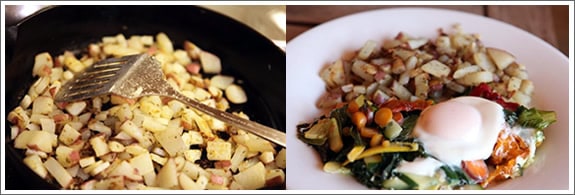
High starch, low moisture potatoes such as Gold Rush, Idaho, and Russets, are best for baking or light, fluffy mashed potatoes. The texture is sometimes described as floury or mealy.
Low starch, high moisture potatoes such as red-skinned varieties hold their shape well and are great for steaming, pan frying, or potato salads. The texture is sometimes described as waxy.
All purpose potatoes are medium starch and work well in most dishes whether they are steamed, roasted, mashed, or fried.
New potatoes are simply red or white potatoes harvested early and are great for salads or roasting. They may not store well so eat them up.
Hopefully others can share some great simple recipes. We want to thrive, not just survive, and growing your own potatoes may be one way to do that!
Resources
Johnny’s Selected Seeds company offers a variety of seed potatoes and a concise guide online about what you should know about growing potatoes.
http://www.johnnyseeds.com/default.aspx
Irish Eyes Garden Seeds - Large selection of Organic, Conventional and unique tubers. http://www.irisheyesgardenseeds.com/index.php?cPath=30&osCsid=3ba799134f5a8b0196d398f239e25f3c
Maine Potato Lady has a wide variety of seed potatoes to order. Check out her guide for growing potatoes and much more.
https://www.mainepotatolady.com/productcart/pc/home.asp
Fedco Seeds has a ton of information in their ”Moose Tubers” catalog and many varieties for seed available.
http://www.fedcoseeds.com/index.htm
Storage and Root Cellars: For more information on root cellars and food storage, get the excellent book Root Cellaring: Natural Cold Storage of Fruits & Vegetables by Mike and Nancy Bubel, 1991.
Also check your State Extension Service for information and publications on growing potatoes and other gardening recommendations particular to your region.
http://umaine.edu/publications/2077e/
This is a companion discussion topic for the original entry at https://peakprosperity.com/growing-your-own-potatoes-2/

